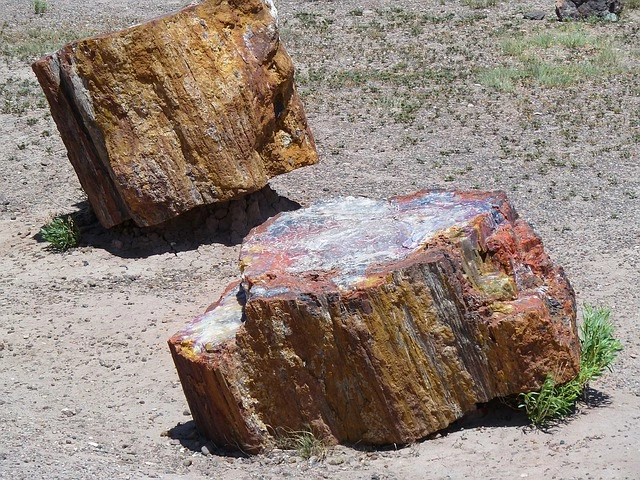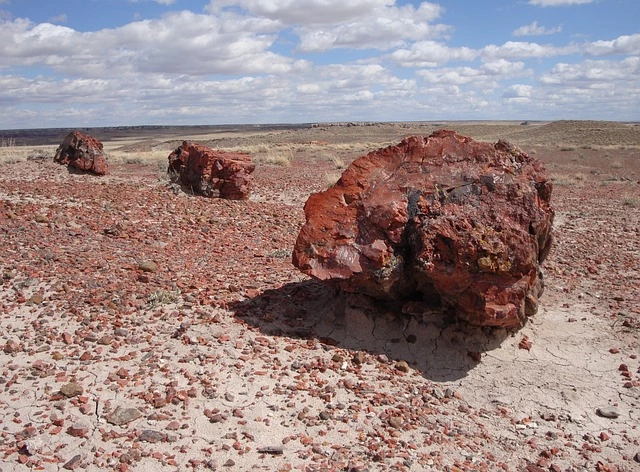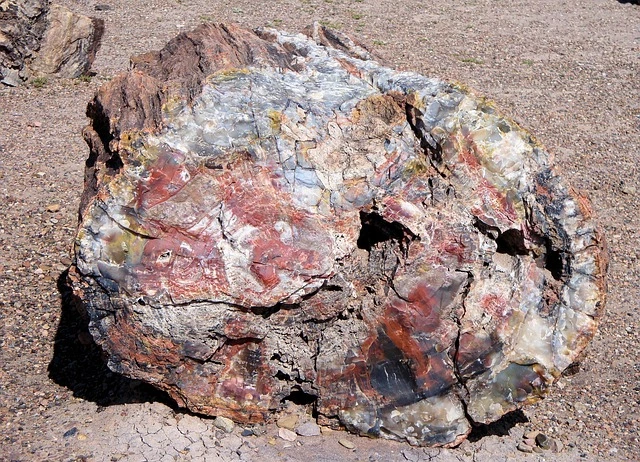
Have you ever wondered what secrets are hidden in the rocks that have withstood the test of time? Imagine how exciting it would be to decipher the stories hidden in ancient trees that have turned to stone. This is the captivating world of carving petrified wood. The process raises fascinating questions: How can something as delicate as wood turn to stone while retaining its original form? In this exploration, we delve into the fascinating art of carving petrified wood, unraveling the geological mysteries and discovering the craftsmanship that brings these ancient masterpieces to life.
Carving petrified wood is a fascinating blend of creativity and science. With chisel and saw in hand, artisans carefully uncover the intricate patterns and colors preserved in these past petrified forests. Petrified wood, replaced by minerals over the eons, is transformed into a durable material that artists can shape into stunning sculptures and functional objects. Discover how modern artists harness the beauty of these ancient trees to create stunning sculptures that not only honor the past but also celebrate the imperishable nature of nature.
But these fossilized treasures aren’t limited to museums. Whether it’s the alluring textures or the ethereal colors, carving petrified wood has become a coveted art form for collectors and enthusiasts worldwide. In our upcoming article journey, we will delve into the world of petrified wood carvings, guided by the insights of renowned geologists and artists who have mastered the craft. Join us as we venture beyond the surface and explore the captivating stories waiting to be revealed in these stone-wrapped relics of ancient forests. Your journey to understanding the art of carving petrified wood begins here, where history, nature and creativity intertwine in an extraordinary dance.
What is petrified wood?
Petrified wood is a fossil in which the organic remains are replaced by minerals when turning to stone. The process takes time and results in Quartz Chalcedony mineralization. Special conditions must be met for the fallen petrified wood to be transformed into petrified wood.

The fallen trees are buried in a zero-oxygen environment known as an anaerobic environment. It preserves the original tree structure and appearance and gives the wood access to mineral-rich water flowing through the wood.
That is how it replaces the organic tree structure with inorganic stone. The result was petrified wood. The process takes place in less than one thousand years. Exotic minerals allow the rare red and green hues seen in rare specimens. Some users call the petrified wood a stone.
Petrified wood is a unique geological formation that revolves around a tree and turns it into stone. It is a stone with a preserved natural wooden texture without organic wood material such as cellulose and lignin. These are now silica minerals and sometimes calcite, pyrite, or native copper.
Types of Petrified Wood
Although there is no strict classification of petrified wood, attempts to classify the wood based on the type of plant. However, not all petrified wood holds the features of the initial plant. Petrified wood separates according to its color and mineral composition.

Types of petrified wood based on color
Quartz
It is the most available mineral on Earth’s surface, composed of SiO2.
Chalcedony
It is a cryptocrystalline variety of quartz. That means it is impossible to observe crystal grains with the naked eye.
Agate
It is a chalcedony type, but the layered texture separates the two.
Opal
It is a mineraloid. It has the same chemical composition as quartz but a different crystal structure. Opal displays color flashes inside the stone, known as the opalescence effect.
Types of petrified wood based on structure and texture
Homogeneous Type
The homogeneous type is a simple wood type with a uniform ring color. It is light-colored and composed.
Spotted Type
The spotted type is a highly decorative one. This structure is a combination of opal and chalcedony.
Jet-like petrified wood
This type of petrified wood shows clear lines. Sometimes it forms wavy patterns.
Concentric Texture
The concentric texture of petrified wood comes with various color layers. Multiple minerals saturate the bands. That is how it comes in different colors. Opal and chalcedony layers change several times to develop a concentric texture.
Lens-shaped or Peanut Texture
Lens-shaped petrified wood is formed by filling wood cavities with other minerals. Cavities are holes bored by actual clams. It results in a black-and-white pattern of petrified wood development.
Can you carve petrified wood?
Yes, you can carve Petrified Wood, although it is hard. Proper tools like a diamond grinding wheel make the process bearable. You can shape your petrified wood into slabs to make your projects using the original wood structure and mineral alteration. You may need a larger blade radius wet saw to cut pieces of petrified wood.

Can you drill into petrified wood?
Using specialized drills and techniques makes it possible to drill into hard material such as petrified wood. Cool the stone and prevent dust from forming. Drilling petrified wood is hard. Remember to run the machine slowly and get the up-and-down action. Do not force the cutting. If you do, the project dulls the bit much quicker
Tools to use
Use a wet saw that accommodates the size and thickness of your petrified wood log. You can also use motorized or large-scale rock cutters with diamond blade saws. Position your wet saw to accommodate the heavy load of petrified wood.
Selecting the right piece of wood
The value of petrified wood has several factors, including size and natural beauty. Familiarize yourself with these factors before you get one to ensure you choose a valuable piece for beautiful projects.
Size
Consider size before you select a piece of wood. The size determines the price of petrified wood. Small pieces of petrified wood are popular and have been mass-produced and polished without expertise. In contrast, large specimens are rarer and more valuable.
They are prized by collectors, who use them as wall mounts and tables. You also find them displayed in universities and museums worldwide. Visit a showroom with a wide variety of sizes to choose from.
Polish
Petrified wood is valued according to how it has been polished. Petrified wood that has been expertly polished is worth more. Some manufacturers do all the cutting and polishing in-house. The stone is sometimes produced in a mirror-like finish.
Color
The color and patterns of petrified wood determine the value of your wood. What makes the color of petrified wood are the minerals it was buried in during the prehistoric age. The more colorful it is, the more it is worth.
Growth Ring
Wood from Oregon and Washington shows the annual ring structure of the original tree clearly. That is an eye-catching feature that adds warmth and interest to the user. Petrified wood from Arizona is easy to identify. It has bright reds, blues, yellows, and pink colors for its unique and valuable character.
Locations
Petrified wood is found worldwide, with special geological and historical significance in different areas. Certain places are known for exceptional occurrences of petrified wood, attracting enthusiasts, collectors and scientists. Let’s take a look at these remarkable places.
- Petrified Forest National Park, Arizona:
Petrified Forest National Park in Arizona, USA, is known for its diverse and well-preserved petrified logs. These logs come from ancient trees formed more than 200 million years ago. The Rainbow Forest area is especially famous for its variety of petrified logs, each of which tells a story from the past. - The Pacific Northwest: Washington and Oregon:
The Pacific Northwest, including Washington and Oregon, is rich in petrified wood deposits. Ginkgo Petrified Forest State Park in Washington features intricate petrified wood pieces with preserved cell structures. John Day Fossil Beds National Monument in Oregon houses fossilized remains that reflect the beauty of petrified logs. - The unique petrified forests of Madagascar:
The petrified forests of western Madagascar are a treasure trove of petrified wood from trees that grew over 200 million years ago. The petrified wood of Madagascar is characterized by its diverse colors, patterns and minerals. From rich reds to earthy browns, it reflects mineralization over time. - Petrified wood around the globe:
While these locations are known for extensive deposits, petrified wood is found worldwide. Local conditions, minerals, and petrification processes contribute to unique fossils. From Argentina’s Petrified Forest National Monument to deposits in Australia and Germany, these remains offer insights into Earth’s history.
Preservation and exploration
Museums, universities, and collectors value these sites for acquiring specimens. Unique features enrich understanding and underscore the importance of preserving these treasures. Whether the living logs in Arizona or the patterns in Madagascar, each site contributes to the global story of petrified wood and its discoveries.
Some Basic Rules for Carving petrified wood
Guidelines for safe and effective carving of petrified wood
Carving petrified wood requires following basic rules to achieve a successful result and ensure personal safety. Take these guidelines to heart to uncover the artistry hidden in ancient stones while minimizing the risks. Let’s dive into the basic principles of carving petrified wood:
- Be sure to maintain a comfortable posture:
When you begin carving, emphasize an ergonomic posture. Sit comfortably to ensure stability and concentration and to prevent fatigue and overwork. - Carve away from your body:
Safety is key. Always carve away from the body to avoid accidental slips and possible injury. - Keep a safe distance:
Keep an arm’s length away from tools to avoid accidents and have better control over the carving process. - Use sharp blade:
Sharp blades are the be-all and end-all of safety. Dull blades slip or go off course, increasing the risk of accidents. Make sure you have well-maintained, sharpened tools. - Focus on one tool at a time:
Precision is key. Work with one tool at a time to master its capabilities and make deliberate, controlled movements. Multitasking can lead to mistakes. - Avoid carving live trees:
Never carve live trees for ethical reasons. Preserve nature and avoid harm. The beauty of petrified wood is in its ancient history; carving petrified trees preserves reverence for the past.
Is petrified wood worth something?
The worth of petrified wood is by quality and size. Small samples of low-quality petrified wood may not be worth anything, while a high-quality petrified wood log sells for several dollars. Large items manufactured from polished petrified wood, such as tabletops, sell for thousands of dollars.
Is petrified wood easy to break?
Petrified wood is more like a stone. It is difficult to break, but using the proper tools and techniques can be bearable.
Where to sell petrified wood
You can sell small pieces as a hobby at art shows and community events. You may join a club or organization dealing with larger quantities of petrified wood. Online sales also pay. You sell online either by creating a website or an auction website. Form a specialized internet auction. eBay is also a powerful website. Other items you can make include Carved Wooden Owls.
How to tell how old petrified wood is
Relative Dating
Relative dating, a technique in geology and paleontology, estimates the sequence of events and fossils without giving numerical ages. Instead, the sequence or relative age of fossils is determined by analyzing sedimentary rock layers. This method is particularly useful for dating fossils within a particular geographic region. Let’s examine relative dating with examples.
Understanding Relative Dating
Relative dating uses the principle of superposition: In undisturbed rock layers, the oldest layer is at the bottom and the youngest is at the top. This principle is based on the deposition of sediments. The analysis of the position of the fossils in the layers shows their relative age.
Fossil succession
Fossil succession is a common method of relative dating. It’s based on specific organisms that existed during specific periods. Scientists create a succession of organisms by comparing fossils in different rock layers. If a fossil species occurs in the lower layer but not in the upper layer, it existed during the formation of the lower layer.
Stratigraphic relationships
Stratigraphy, the study of rock layers, is critical to relative dating. Strata contain fossil assemblages reflecting environmental, climatic, and ecosystem changes. Vertical analysis of strata and their fossils can determine the sequence of events.
Practical application
Imagine a paleontologist finding sedimentary rock layers. In them are various fossils, from simple marine organisms to complex land creatures. By analyzing the fossil sequence, conclusions can be drawn about the age of the organisms and the changing habitats.
Constraints and Interpretation
Relative dating ranks events, but not with numerical precision. It assumes undisturbed rock layers challenged by geologic processes such as folding or erosion. Accurate interpretation depends on a solid understanding of the geology of the area.
Biostratigraphy
Biostratigraphy, a stratigraphic dating method, uses certain fossilized organisms, called guide fossils, to determine the age of rock strata. By analyzing fossil assemblages in sedimentary rocks, scientists can infer the sequence of strata and gain insight into Earth’s life history. Let’s take a closer look at biostratigraphy.
Understanding Biostratigraphy
Biostratigraphy relies on organisms that occur during specific time intervals. These organisms, which often exhibit certain characteristics, signal the age of rock strata. Scientists create a relative timeline of events by identifying guide fossils and comparing their occurrence in different strata.
Example from context: trilobite fossils
Trilobites, marine arthropods, are guide fossils in biostratigraphy. These creatures lived in different geologic periods and adapted to their environment. The finding of a trilobite species indicates the age of the stratum in which this species lived.
Use of fossil ranges
Biostratigraphy evaluates the range of index fossils — how long they existed. Some had a short life span. Others were more widespread. Comparing different index fossil ranges narrows down the age of the strata.
Stratigraphic zonation
Biostratigraphy groups rock layers into zones with specific index fossils. Each zone represents a particular geologic period. By analyzing the index fossil transitions between zones, the age of the rock layers can be deciphered.
Practical application
Imagine a paleontologist examining rock layers in different locations. Matching index fossils indicate specific periods. A correlation can be made between the rock layers and a broader chronology by comparing the range of index fossils at different locations.
Limitations and Interpretation
Biostratigraphy is useful for relative dating because it relies on accurately identifying index fossils and their distribution. The method’s effectiveness is hampered by variability in fossil preservation and distribution. The method assumes a steady evolution of species, which isn’t always the case.
Radiometric Dating
Radiometric dating is a powerful technique used in geology and archaeology to determine the ages of rocks, minerals, fossils, and archaeological artifacts. This method relies on the principles of radioactive decay, a natural process through which unstable atoms transform into more stable ones over time. By analyzing the ratios of parent and daughter isotopes in a sample, scientists can deduce how much time has elapsed since the rock or mineral formed. Let’s delve into the details of radiometric dating and explore a few examples to illustrate its significance.
Principles of Radiometric Dating: Radiometric dating is based on the concept of isotopes, variants of the same element with different numbers of neutrons. Some isotopes are unstable and undergo radioactive decay, transforming the unstable parent isotope into a stable daughter isotope. The decay rate is constant and can be quantified as a half-life, the time it takes for half of the parent isotopes to decay.
The ratio of parent isotopes to daughter isotopes changes over time as decay occurs. By measuring these ratios in a sample and knowing the half-life of the radioactive isotope involved, scientists can calculate how much time has passed since the rock or mineral formed.
Examples of Radiometric Dating:
- Carbon-14 Dating: One of the most well-known examples of radiometric dating is carbon-14 dating. Carbon-14 is an isotope of carbon in the atmosphere and is absorbed by living organisms. When an organism dies, it stops taking in carbon-14, and the existing carbon-14 within its tissues begins to decay. By measuring the ratio of carbon-14 to carbon-12 in a sample, scientists can estimate the age of the organic material. This method is commonly used to date archaeological artifacts and ancient remains.
- Uranium-Lead Dating: Uranium-lead dating is often used to determine the ages of rocks and minerals, particularly those containing zircon and monazite. Uranium-238, a parent isotope, decays into lead-206, a stable daughter isotope, through a series of intermediate decay steps. By measuring the ratios of uranium and lead isotopes, geologists can calculate the age of the rock or mineral. This method is valuable for dating the Earth’s oldest rocks and providing insights into the planet’s geological history.
- Potassium-Argon Dating: Potassium-argon dating dates volcanic rocks and minerals that contain potassium, such as feldspar and mica. Potassium-40, a parent isotope, decays into argon-40, a stable daughter isotope. This method is particularly useful for dating volcanic ash layers and understanding the timing of past volcanic eruptions.
Limitations and Accuracy: While radiometric dating is a powerful tool, it’s essential to acknowledge its limitations. The accuracy of radiometric dating depends on factors such as the initial isotope ratios, the presence of contaminants, and the assumption of a constant decay rate over time. Despite these challenges, scientists have refined their methods and calibration techniques to improve the accuracy of radiometric dating results.
- Grain and Sheen: Teak Oil versus Danish Oil Uncovered - January 10, 2024
- The Cherry on Top: Crafting the Perfect Cutting Board - January 9, 2024
- Polyurethane Water-Based vs Oil-Based: Choosing the Right Finish - January 8, 2024
